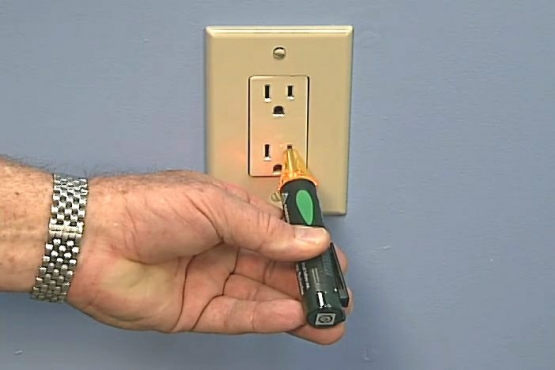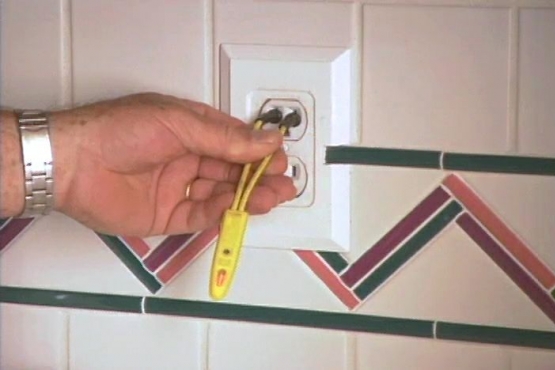RH: My first stop here in the lone star state is Houston. Diane Drake loves to relax in her back porch enjoying the sights and sounds of nature but, it’s often just too dog gone hot for comfort. So, she’s asked me to help install a ceiling fan. We step out back and she shows me where it’ll go. That’s where it’s going to go, right up there?
DD: That’s right.
RH: On the old light fixture. Okay. All right. Now the first thing we’re going to have to do is take this light fixture down. All right? So, let’s move this table out of the way. We should be able to get to that pretty easily. Maybe we can carry it right over here. Okay. Just come right toward me. Perfect. Okay. Good. So, the power is off now. By the way we’re using fiberglass ladders here because anytime you’re working on electricity you don’t want to use a metal ladder. So, either wood or fiberglass.
DD: Okay.
RH: Let’s start by taking this fixture. Now here’s a screwdriver.
DD: Okay.
RH: I’ve got a rubber handled screwdriver here, good for electrical work. Just go ahead and take that screw right down. Now, I’ve got to tell you something, I’ve never had that serenading while I was doing a home improvement project as I have with these birds. Is she a regular resident?
DD: She is a permanent resident.
RH: What time does she start?
DD: She starts at three in the morning and ends about ten at night.
RH: From three in the morning?
DD: Three. Starts at three.
RH: Now, it’s at this point that a lot of people make a mistake. They tray to attach the fan to the existing electrical box that was really designed only to support the weight of a light. We’re going to take this out and replace it with a heavy duty box up here. Diane, this is the new brace or bracket that we’re going to use to install your fan. As you can see it’s quite heavy duty. It’s designed to be installed from the bottom. What I’ve made up right here is a little mock up because when we get up inside the ceiling it’s going to be very hard to see what’s going on. Let’s assume that this is your ceiling up here kind of looking down. The way this works is you simply slip this in through the hole that we already had cut up there. Notice these points right here? These are really important. I’ll show you how those work in just a second. Now, you shove it up in like this. Now it’s sort of sitting on the top of the ceiling. You move it around until it’s over the hole like this and then by rotating this bar those sharp points are going right into the sides of the joist. That’s what holds this up here. Okay. Now, Diane I want you to step around here if you would . . .
DD: Okay.
RH: . . . and do the next part of this. Okay. Just come around where I was. Now to this bar we are going to attach a bracket so again working from the bottom slip that up inside and over the bar, way up in. You want to put that over the top. Can’t do it that way! I didn’t mean to startle Diane. I just wanted her to do everything by reaching up from the bottom like she’ll have to do in the real ceiling.
DD: Okay.
RH: All the way up until it touches. There you go. Then you’re going to put these lock nuts on. This is the electrical box inside of which we are going to make all of our wiring connections. So, this just slips right out from the bottom, pushed up through the hole onto these long bolts right here.
DD: Okay.
RH: All the way up until it touches the top of this bracket up here.
DD: There we are.
RH: Perfect. Then to hold that in we’ll use these nuts right here. Okay. Perfect. Now let’s do this for real.
DD: Let’s do it.
RH: Okay. Take the part. The final step is to attach a stand mounting bracket to the junction box. The ceiling fan will actually hang from this. Now, we turn our attention to the fan itself. This is the fan motor and we’re going to do a little assembly so that we can attach this to that bracket that we put up on the ceiling. We’re going to lower the fan down from the ceiling just about this amount, about twelve inches. I think that’s going to give you better air circulation, so to do that we’re going to run these wires through here. Okay. Great. Yeah, just pull them all the way through. There you go. We’re going to drop this right down here and we’re going to attach this to the fan motor and we’ll secure that with this cotter pin which drops right in here like that.
DD: Okay.
RH: This fan is going to be outdoors. We’ve got to keep moisture from kind of leaking in around here into the motor itself and that’s what this little rubber boot is for. Bring it all the way down. There you go. Then just put it right over that. Perfect. Now, we’re going to connect the top end. This is the end that’s going to attach to the ceiling. This is going to cover actually the bracket up there.
DD: Okay.
RH: Eventually. It’s more of a cosmetic thing than anything else. Then if you would thread the wires through this. This is going to go on the other end of the pipe and that’s going to allow us to attach this to the bracket you just put up. Once again, I’m going to slide this pin through. To hold that in position there is a little set screw right here. We’ll tighten that. Okay. Now, we’re ready to go attach this to the ceiling bracket. All right. Now, we’re all set.
DD: Great!
RH: We’re going to hang this up. Just take this in your hands.
DD: Okay.
RH: This ball right here goes right in that bracket we put up earlier. Just lift it up and slip it in. Okay. Then let go. That’s going to take all the weight. Every fan is wired a little bit differently but, the general rule here is you hook all wires of the same color together. All the black wires together. All the white wires together. Okay. Now we’ve cut the wires to length. Now we’re going to strip off the insulation. There we go. And simply twist the two together. These are the two white wires. Diane can you hand me one of those wire nuts down there.
DD: The little yellow ones?
RH: Yeah, that’s it. Thanks very much. Now that all the wires have been connected we’re going to tuck these back up in the box very neatly like that and then slide the canopy up. So, go ahead Diane and slide that right up there.
DD: Okay.
RH: There should be a screw on your side as well as one on mine.
DD: There’s mine.
RH: Okay. I’m going to get mine on here. Good. Just a little twist. All right. Last step. We’re going to put the fan blades on.
DD: Okay.
RH: These just simply screw on to the bottom of the motor here. If you’ll hold that in place I’ll put the screws in here. I generally don’t tighten the first screw all the way so we can have a little leeway to move that around. Well, the sun is going down. The birds have quieted for the most part. It’s cooled off a bit and I got to tell you the breeze from this fan is wonderful. This is so comfortable out here. This is a great house call. Thanks for having us over.
DD: Thank you.
RH: Cheers.
DD: Cheers.









